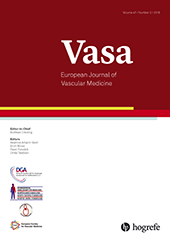Osteoprotegerin concentration is associated with the presence and severity of peripheral arterial disease in type 2 diabetes mellitus
Abstract
Abstract.Background: Osteoprotegerin plays a role in the development of several bone diseases. In addition, osteoprotegerin may contribute to the development of vascular disease. Little is known about the association between serum osteoprotegerin levels and the presence or severity of peripheral arterial disease (PAD). The aim of this study was to examine the association between serum osteoprotegerin levels and both the presence as well as the severity of lower extremity arterial disease in patients with type 2 diabetes (T2DM). Patients and methods: The study included 165 consecutive patients with T2DM (57 % males, mean age 65.0 ± 0.7 years). PAD was diagnosed by measurement of the toe-brachial index (TBI). Serum osteoprotegerin was measured using ELISA. Results: The mean osteoprotegerin level was significantly higher in patients with PAD in comparison to patients without PAD (18.2 ± 1.0 vs. 13.1 ± 2.0 pmol/L, p = 0.014). Significant univariate correlations between TBI and osteoprotegerin level (r = –0.308; p < 0.001), age, body mass index, and HDL cholesterol were observed. In the multivariate linear regression analysis, serum osteoprotegerin (β = –0.005; p = 0.020), higher age, and male gender were significant predictors of TBI. When 25(OH) vitamin D was introduced into the mentioned model, OPG was no longer a significant predictor of TBI and was replaced in the model with vitamin D (β = 0.009, p = 0.001). This finding suggests a role of OPG as a mediator of the effects of 25(OH) vitamin D. Conclusions: Serum osteoprotegerin level is significantly associated with both the presence and severity of PAD in patients with T2D. Osteoprotegerin might be a biomarker for the presence of atherosclerotic disease in patients with T2DM.
Literature
TNFRSF11B gene polymorphisms increased risk of peripheral arterial occlusive disease and critical limb ischemia in patients with type 2 diabetes. Acta Diabetol. 2014;51:1025–32.
Association of osteoprotegerin with peripheral artery disease in patients with type 2 diabetes. Arch Cardiovasc Dis. 2015;108:412–9.
Osteoprotegerin is higher in peripheral arterial disease regardless of glycaemic status. Thromb Res. 2010;126:e423–7.
Osteoprotegerin is a risk factor for progressive atherosclerosis and cardiovascular disease. Circulation. 2004;109:2175–80.
. Osteoprotegerin plasma concentrations correlate with severity of peripheral artery disease. Atherosclerosis. 2005;182:175–80.
. Osteoprotegerin and osteopontin are expressed at high concentrations within symptomatic carotid atherosclerosis. Stroke. 2004;35:1636–41.
Assessment of the genetic effects of polymorphisms in the osteoprotegerin gene, TNFRSF11B, on serum osteoprotegerin levels and carotid plaque vulnerability. Stroke. 2011;42:3022–8.
. Enhanced T-cell expression of RANK ligand in acute coronary syndrome: possible role in plaque destabilization. Arterioscler Thromb Vasc Biol. 2006;26:857–63.
. Serum levels of osteoprotegerin and RANKL in patients with ST elevation acute myocardial infarction. Clin Sci (Lond). 2005;109:389–95.
Dysregulated osteoprotegerin/RANK ligand/RANK axis in clinical and experimental heart failure. Circulation. 2005;111:2461–8.
. Associations of serum osteoprotegerin levels with diabetes, stroke, bone density, fractures, and mortality in elderly women. J Clin Endocrinol MeTab. 2001;86:631–7.
Plasma osteoprotegerin is related to carotid and peripheral arterial disease, but not to myocardial ischemia in type 2 diabetes mellitus. Cardiovasc Diabetol. 2011;10:76.
Association of plasma osteoprotegerin levels with the severity of lower extremity arterial disease in patients with type 2 diabetes. BMC Cardiovasc Dis. 2015;15:86.
. Sensitivities of in vivo markers of arterial organ damage in patients with peripheral atherosclerosis. Vasa. 2018;47:30–35.
. Associations of candidate biomarkers of vascular disease with the ankle-brachial index and peripheral arterial disease. Am J Hypert. 2013;26:495–502.
. Prevalence and risk factors of PAD among patients with elevated ABI. J Vasc Endovasc Surg. 2008;35:709–14.
. Utility of the toe-brachial index for diagnosis of peripheral artery disease. Arch Plast Surg. 2012;39:227–31.
. Ankle-brachial index, toe-brachial index, and cardiovascular mortality in persons with and without diabetes mellitus. J Vasc Surg. 2014;60:390–5.
Inter-Society Consensus for the Management of Peripheral Arterial Disease (TASC II). Eur J Vasc Endovasc Surg. 2007;33:S1–75.
2011 ACCF/AHA focused update of the guideline for the management of patients with peripheral artery disease (updating the 2005 Guideline). A report of the American College of Cardiology Foundation/American Heart Association Task Force on Practice Guidelines. J Am Coll Cardiol. 2011;58:2020–45.
. The osteoprotegerin /RANK/RANKL system: a bone key to vascular disease. Expert Rev Cardiovasc Ther. 2006;4:801–11.
. Osteoprotegerin inhibits calcification of vascular smooth muscle cell via down regulation of the Notch1-RBP-Jκ/Msx2 signaling pathway. PLoS ONE. 2013;8:e68987.
Serum osteoprotegerin and osteopontin levels are associated with arterial stiffness and the presence and severity of coronary artery disease. Int J Cardiol. 2013;167:1924–8.
. REVIEW: Circulating osteoprotegerin and receptor activator for nuclear factor-κB ligand: clinical utility in metabolic bone disease assessment. J Clin Endocrinol Metab 2005;90:6323–31.
Polymorphism rs2073618 of the osteoprotegerin gene as a potential marker of subclinical carotid atherosclerosis in Caucasians with type 2 diabetes mellitus. Vasa. 2017;46:1–8.
. Peripheral arterial disease in patients with diabetes. J Am Coll Cardiol. 2006;47:921–9.



